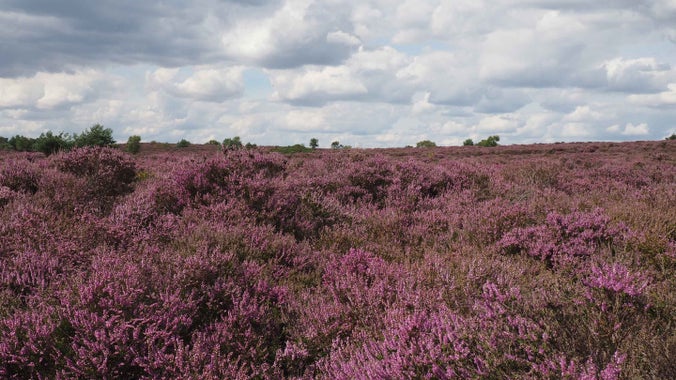Heathland species increase as Dunwich heather continues recovery

After the UK’s warmest and sunniest spring, followed by the hottest summer on record, heathland species are continuing to show signs of dramatic recovery at the National Trust’s Dunwich Heath - just three years after similar heat waves caused serious damage to the rare heathland habitat.
Dunwich Heath is the last large area of coastal heathland on the Suffolk coast and home to three types of heather – common, bell and cross-leaved.
In 2022, the heathland was ravaged by extreme heat and prolonged drought, creating visible areas of die-off and raising concerns for the species that live there.
But this year, despite the record-breaking summer heat, the habitat and reliant species have shown amazing signs of recovery thanks to its careful and controlled management.
Rangers at the National Trust site have recorded over 130 different species of moth as part of their fortnightly surveys, including 54 sightings of True Lover’s Knot Lycophotia porphyrea, a heathland specialist that was badly impacted in 2022.
This small reddish-brown moth commonly found in heathland habitats, typically flies between June and August and is attracted to light. Before pupating into a moth, its caterpillars feed on heather flowers which usually peak in July and August, before spending the winter hidden in leaf litter or just below the soil surface.
Sam Cooper, Area Ranger at National Trust Dunwich Heath, says: “Last year, we recorded a peak of just five, but this year that’s rocketed to 54. It’s an incredible increase and a really positive sign that the heathland is not only recovering, but that it’s also very healthy.”

Another success story is a rebound in the fortunes of the Dartford warbler, with numbers this year returning to pre-2022 levels.
This small, native, long-tailed warbler relies on finding year-round food sources, such as insects and other invertebrates.
In 2023, the year after the habitat was badly damaged by drought and extreme heat, the number of breeding pairs almost halved, dropping from 30 down to 17, likely due to the deferred impact of the drought on over-wintering insects and larvae on which the birds feed. In 2024, 25 pairs were recorded, and this year, that number has increased to 29.
Sam added: “For Dartford warblers, the increase in breeding pairs is particularly encouraging, because it suggests that they’re able to find the food sources they need, not just to survive, but to actually thrive as a species.”

As for the heather itself, specialist drone surveys conducted in 2023 after the heatwave revealed that there had been a 60 per cent loss in heather, but thanks to increased rainfall in February 2024, the heather recovered by more than 10 per cent and by a further similar amount this year. With continued management, and no extreme weather events, the team expect this trend to continue over the coming years.
Sam continued: “Whilst the site and species are undoubtedly being impacted by climate change and extremes of weather, we are working to mitigate these impacts as far as we reasonably can and aid recovery through ongoing monitoring and informed practical habitat management.
“Although we’ve carried out annual heather management at Dunwich for decades, in 2023 together with our volunteers we started the first of several trials to help establish the quickest method to restore the heather impacted by drought conditions.
“This year, the work has included increased bracken and sapling management and higher cuts, which means leaving more of the vegetation to grow and less of the ground bare, while still removing dead heather and reducing the risk of fire.
“While heather re-establishes well on bare ground, it’s thought that a higher cut potentially helps to retain moisture by reducing exposure to the sun and the risk of it evaporating.
“By making lots of very small cuts, this should allow new growth to establish quicker without risking changes to the microclimate, or exposing the heather to harsh frosts in winter, and we’re cautiously optimistic that we’ll see further recovery across Dunwich Heath in 2026.”
Matt Wilson, Countryside Manager for the National Trust Suffolk & Essex Coast portfolio, says: “The team at Dunwich Heath have done an incredible job in mitigating the damage that occurred to the heathland three years ago – not only to aid its recovery, but also to prevent the very real risk of wildfires.
“These have been even more of a concern this year, during what has proved to be the hottest UK summer on record, with four separate heatwaves. Hard work, and learning from previous experience, has really helped the team to monitor, maintain and help the habitat recover, in truly difficult conditions.
“We encourage visitors to help us do this, looking after the heathland by taking litter home, keeping dogs on leads where signposted to do so, staying on the paths and not lighting barbecues, fires or cigarettes, as these can easily ignite dry vegetation where fire can spread rapidly and destroy these special and rare habitats.”